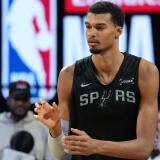NBA teams are playing at a breakneck pace, scoring like crazy and it's not going to stop any time soon
Point totals and pace are up significantly from last season, so what exactly is going on?
On an unseasonably wet and gusty May day in 1954, 25-year-old Roger Gilbert Bannister took his mark on the Iffley Road track in Oxford, England. Just three minutes and 59 seconds later, Bannister's name was forever etched in sports history as the first person to officially run a mile in under four minutes. Among many front pages worldwide, the New York Times lauded Bannister for achieving "one of man's hitherto unattainable goals," a mark that was expected to stand for quite some time.
It lasted 46 days.
Since Bannister's legendary race, nearly 1,500 athletes have registered four-minute miles, and it has become the standard by which mile-runners are judged. It was a seminal moment for distance runners -- seeing Bannister achieve a formerly unreachable milestone unlocked hope and potential within competitors which allowed them to not only equal him, but surpass him.
That's exactly what we're seeing in the NBA so far in the 2018-19 season, where a frenetic pace and staggeringly high point totals on a nightly basis have caused even the most casual fan to raise an eyebrow. The description for Malcolm Gladwell's 2000 bestseller, "The Tipping Point: How Little Things Can Make a Big Difference," defines the titular term as "that magic moment when an idea, trend, or social behavior crosses a threshold, tips, and spreads like wildfire."
Looking at this season's mind-boggling numbers regarding pace (estimated number of possessions per game) and scoring, it's safe to say that the NBA has reached a tipping point. Here are some stats to show you just what we're dealing with:
*Statistics accurate as of Oct. 25
- Last season teams averaged 106.3 points per game. That number is up to 113.4 this season, which would be the biggest single-season increase since 1954-55, when scoring went from 79.5 to 93.1.
- Last season there were five teams that finished with a pace over 100 (Pelicans, Suns, Lakers, 76ers, Warriors). This season there are only four teams under 100 (Grizzlies, Nets, Pacers, Spurs), and none are below 97.
- Last season the Lakers led the league with 19.5 percent of their scoring opportunities coming in transition. This season there are eight teams higher than that, including the Lakers at the top again at 26.7 percent.
- The season-high point total from last season, 148 (by Houston and Oklahoma City) was surpassed on the fourth day of the 2018-19 season by the New Orleans Pelicans (149 points against the Kings).
- Last season, a team scored over 140 points in a game 13 times -- it's already happened five times this season in just over a week (Pelicans, Lakers, Mavericks, Spurs, Warriors).
- For those of you who may think this is a product of the offense being ahead of the defense early in the season due to conditioning issues, keep in mind that last October teams scored over 120 points in a game 27 times. This October, still with a week left, it's already happened 36 times.
Pace and space
This season's average pace, 101.8, would be the highest since the 1985-86 season. The rapid style that was popularized by the "seven seconds or less" Suns of the mid-2000s and was carried on by teams like the Denver Nuggets, Houston Rockets and Golden State Warriors, has now fully infiltrated the league. As an illustration of how far and how quickly things have progressed, the fastest Mike D'Antoni Suns team played at a pace of 96.7 -- that would place them dead last this season.
For all the advanced statistics and analytics that permeate NBA front offices, the scoring revolution of the past few seasons has been based on arithmetic even the most unfocused of second-graders can grasp: Three is more than two. Led by extreme examples like the Houston Rockets, who last season became the first NBA team ever to shoot more 3s than 2s, the average number of 3-point attempts per game has risen every season since 2010-11, with teams firing up 31.6 attempts per game so far this season. Obviously that contributes to the increased scoring, but that's not the only factor.
Pushing the pace stems from another simple math equation -- more shots equals more points. By pushing the ball in transition and taking shots earlier in the shot clock, your field goal attempts continue to rise. Assuming teams will make about 45 percent of their shots, those extra attempts will lead to significantly more points. As such, one of the first stat categories that Warriors coach Steve Kerr checks immediately following games is the discrepancy between his team's field goal attempts and the opponent's. Golden State, of course, was at the forefront of pushing the pace starting when Kerr took over for Mark Jackson before the 2014-15 season. The Warriors bumped their pace from 97.4 to 99.3 that season, and have been almost exactly at 100 for the past three. This year, like pretty much everyone else in the league, their pace is up.
The Washington Wizards have increased their tempo significantly this season, going from 97.7 last season to 106.8 so far this year, and coach Scott Brooks points to another benefit of playing fast and getting up more shots -- it helps keep players engaged.
"It definitely gives more shot opportunities for players," Brooks said. "Everybody in this league wants to shoot the ball, so it spreads out the shots and everybody gets a chance to score. ... We like it. We want to play fast."
Part of the reason pushing the pace and shooting more 3-pointers go hand-in-hand is the confusion and defensive cross-matches that transition creates. The faster you get the ball up the court, the quicker decisions the defense has to make. As you can see in this clip from the Raptors, who significantly increased their pace last season and have continued that trend under new head coach Nick Nurse, a transition scramble leaves dead-eye shooter CJ Miles open for a split-second, and that's all the space he needs to splash in a 3-pointer just six seconds into the shot clock.
As recently as a few years ago this would have been considered a horrible shot -- a contested 3-pointer from well beyond the line after a single pass. But now shots like this aren't only tolerated, they're encouraged. It's a similar thought process to teams that decide not to call a timeout after a rebound on the final possession of a game. Why allow the defense to get set when you have the advantage of unpredictability? After a blocked shot, watch as new Raptor Kawhi Leonard notices his defender on his heels, then squares up to knock down a pull-up 3-pointer just six seconds into the possession.
Shots like this are no longer anomalies. They're the norm.
Rule changes
Kerr agrees that the up-tempo style is appealing to players, adding that the league has noticed how much fans enjoy watching his team, in particular. He said that the rule changes implemented by the NBA over the past few seasons have encouraged a faster, higher-scoring game.
"I think the league has recognized that it's a popular style and so they're kind of tightening the rules and encouraging that style of play with the rule changes, the subtleties within the rule -- not just the changes, but within the interpretations of the rule," Kerr said of the league-wide increased pace. "So everything is geared toward the offense right now."
Starting in 2004, when the NBA eliminated hand-checking above the free throw line, the league has shifted more toward perimeter play rather than post-ups. This season, new rules addressing "freedom of movement" have made it even more difficult for defenses to contain potent, wing-heavy offenses that have become so popular.
This isn't unique to the NBA. The NFL has enacted similar rule changes over the years to limit contact between defensive backs and receivers, leading to more effective passing and increased scoring. Ultimately both leagues are trying to serve their audience, and the regulations encourage a more up-tempo, entertaining style.
Here, NBA head of referee development and training Monty McCutchen breaks down the new rules with some video examples.
2018-19 Points of Education (POE) Video: VP, Head of Referee Development & Training Monty McCutchen highlights game rules for 2018-19: Here is Monty on Freedom of Movement: Perimeter & Post. For entire POE video, visit https://t.co/cuOspJGQdY pic.twitter.com/kuAdJvUnqe
— NBA Official (@NBAOfficial) September 28, 2018
One of the prevailing strategies for containing perimeter shooters who run off of screens is to be extremely physical with them off the ball. It was popularized with "The Jordan Rules" enacted by the Detroit Pistons against a prime Michael Jordan, and we've seen similar treatment for players like Stephen Curry over the past few seasons.
Now those bumps and grabs are called fouls, which not only leads to more points being scored (free throws and fouls are both up significantly this season), but it also leads to a much easier path for shooters to work off of screens and out to the 3-point line.
"I just notice the [increased] points," Curry said after watching the end of the Spurs' 143-142 win over the Lakers from the Warriors' locker room following a win over the Suns. "I don't know if that's the way it's officiated or if teams stack the rosters with faster, more versatile guys for more consistent parts of the game. I really don't know exactly what the cause is, but it's great for the offensive-minded guys."
Two days later, Curry scored a season-high 51 points and made 11 3-pointers in three quarters in a 144-122 win over the Wizards.
The downside
As more teams play faster, they're quickly finding out how difficult it can be. The Miami Heat have gone from the third-slowest pace in the league last season (96.2) to 17th this season (102.4). All-Star guard Goran Dragic noted the obvious -- that playing at a faster pace makes players more fatigued, which can lead to defensive sloppiness and turnovers.
First-year Phoenix Suns coach Igor Kokoskov pointed out another important factor in playing fast: Defense. The Suns were second in the NBA in pace last season (101.3), but were last in defensive efficiency. This season, while everyone has increased their pace, the Suns have remained about the same (101.9).
"There's a lot of misunderstanding and misperception when it comes to the pace," Kokoskov said. "We played at a high pace the last couple of years and it didn't really affect our winning and losing record. You know, everybody wants to play fast. That's ideal -- talk about the beauty of the game of basketball -- but we want to win the games first. We have to defend. We have to be an elite defensive team to establish that pace. That's what Golden State did in all these years. We want to play fast, but we want to win the games first."
The statistics back up Kokoskov's claim. Last season the league's two best defenses, the Jazz and the Celtics, were 25th and 23rd, respectively, in pace. When you're able to do what the Warriors have done for the past few seasons or what the Rockets did last year -- play fast with a top-five or top-10 defense, that's when you become a legitimate championship contender.
Whether teams can get to that level remains to be seen, but it's clear they're going to try, and it's easier to start by pushing the pace than to suddenly establish an elite defense.
"You throw it all together, kind of where the league has been trending, and our own success and the success of some of the other fast teams over the last few years," Kerr said. "I think it all is sort of coming to a head, and now everyone is playing that way."


















